Austin, Texas, Hgh State Clinic, Hgh Injections, Hrt Doctors
Austin, Texas Blood Testing Facilities
 Represents a LabCorp blood testing facility
Represents a LabCorp blood testing facility Represents a Quest Diagnostics blood testing facility
Represents a Quest Diagnostics blood testing facility
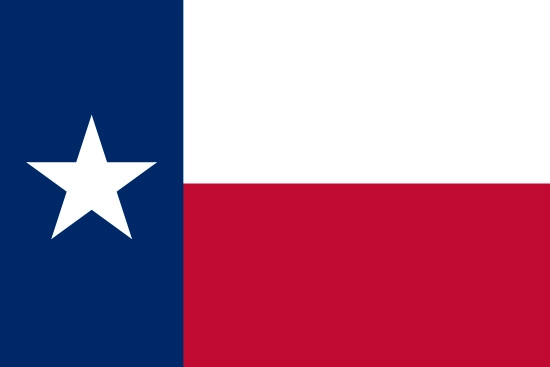
Nearby Labcorp Blood Testing facilities:
- Labcorp Center Distance: 2 m, 711 W 38Th St Suite B-2, Austin, Travis County, TX, 78705
- Labcorp Center Distance: 3 m, 4207 James Casey St Ste 101, Austin, Travis County, TX, 78745
- Labcorp Center Distance: 16 m, 16030 Park Valley Suite 200, Round Rock, Williamson County, TX, 78681
- Labcorp Center Distance: 42 m, 2115 Stephen's Place 1200, New Braunfels, Comal County, TX, 78130
- Labcorp Center Distance: 43 m, 1528 Common St Ste 6, New Braunfels, Comal County, TX, 78130
- Labcorp Center Distance: 61 m, 12602 Toepperwein Rd Ste 220, Live Oak, Bexar County, TX, 78233
- Labcorp Center Distance: 63 m, 19016 Stone Oak Parkway 265, San Antonio, Bexar County, TX, 78258
- Labcorp Center Distance: 66 m, 8601 Village Dr Ste 202, San Antonio, Bexar County, TX, 78217
- Labcorp Center Distance: 67 m, 124 E Bandera Rd Ste 303, Boerne, Kendall County, TX, 78006
- Labcorp Center Distance: 72 m, 5282 Medical Dr Ste 190, San Antonio, Bexar County, TX, 78229
- Labcorp Center Distance: 73 m, 343 W Houston St Ste 308, San Antonio, Bexar County, TX, 78205
- Labcorp Center Distance: 75 m, 3103 S.E. Military Dr Ste 104, San Antonio, Bexar County, TX, 78223
- Labcorp Center Distance: 78 m, 3903 Wiseman Blvd Suite 219, San Antonio, Bexar County, TX, 78251
- Labcorp Center Distance: 79 m, 7390 Barlite Blvd Ste 135, San Antonio, Bexar County, TX, 78224
- Labcorp Center Distance: 89 m, 1602 Rock Prairie Rd Ste 260, College Station, Brazos County, TX, 77845
- Labcorp Center Distance: 90 m, 2410 Wycon Drive Suite 104, Waco, McLennan County, TX, 76712
Nearby Quest Blood Testing facilities:
- Quest Center Distance: 2 m, 3708 Jefferson Street, Austin, Travis County, TX, 78731-6206
- Quest Center Distance: 14 m, 2301 Ranch Rd 620 South, Lakeway, Travis County, TX, 78734-6240
- Quest Center Distance: 22 m, 651 N. Us Hwy 183, Leander, Williamson County, TX, 78641-7001
- Quest Center Distance: 51 m, 305 Singing Oaks, Spring Branch, Comal County, TX, 78070-6505
- Quest Center Distance: 58 m, 2300 S Clear Creek Rd, Killeen, Bell County, TX, 76549-4984
- Quest Center Distance: 62 m, 18707 Hardy Oak Blvd, San Antonio, Bexar County, TX, 78258-4891
- Quest Center Distance: 72 m, 1303 Mccullough Ave, San Antonio, Bexar County, TX, 78212-5628
- Quest Center Distance: 74 m, 6100 Bandera Road, San Antonio, Bexar County, TX, 78238-1666
- Quest Center Distance: 91 m, 7125 Sanger Avenue, Waco, McLennan County, TX, 76712-3981
Austin Hormone Replacement Therapy Services
Have you ever considered Hormone Replacement or Optimization? There are millions of men and women across the United States that have benefited from restorative and replenishing Hormone Treatments, and if you are suffering from symptoms of Hormone Deficiency, these treatments can be potentially life-changing! Our Hormone Clinic serves the entire Austin area, and we have affiliates all throughout the Austin, Texas metro area. We can even arrange for them to meet at your home or office!
The Conscious Evolution Institute prides itself on the quality treatments that it makes available for its patients, and we can arrange for you to meet a licensed and board certified medical professional in your area that can perform the preliminary examination on our behalf to set you up on the path to optimized health and wellness.
With just a short physical and blood sample, we have all we need to provide you with an in-depth look at your health and hormone profile, and we can determine a course of treatment that specifically meets your needs as a patient. If you are interested in the Hormone Services we provide, and would like to know more, and perhaps set up an appointment, we encourage you to fill out the form on this page to get started. If you prefer, you can contact us via the number at the top of this page!
Austin Human Growth Hormone Therapy for HGH Deficiency
Human Growth Hormone is one of the most important and vital hormones produced by the human body. It is secreted by the pituitary gland, and is primarily responsible for supporting and maintaining cellular metabolism. Cellular metabolism means so much more than simply calorie-burning power. HGH helps your body keep up with your needs, and helps preserve health and wellness.
If you have started to notice changes in your health as you grow older, understand that it may not be the result of aging, but Hormone Deficiency. HGH Deficiency is characterized by a number of symptoms. It causes you to gain weight and lose muscle mass. Also, HGH stimulates cellular processes associated with a healthy immune system, and it helps you heal and recover from both injury and daily wear and tear. It leads to feelings of fatigue and even depression. There is even evidence that Growth Hormone Deficiency has a negative impact on cognitive function and memory.
If, over the past few years, you've noticed your body physically slow down, it would benefit you significantly to talk to a specialist about HGH Deficiency and Bio-Identical Human Growth Hormone Treatment.
Austin Sermorelin Acetate Therapy for Natural Growth Hormone Restoration
Although we do offer HGH Injections, and Growth Hormone Injections are highly effective at treating Growth Hormone Deficiency, we also offer an alternative treatment known as Sermorelin Acetate Therapy. Sermorelin is a derivative of a natural hormone produced by the Hypothalamus known as GH-RH, or Growth Hormone-Releasing Hormone. Sermorelin perfectly replicates the function of this hormone, stimulating HGH Production in a normalized and stable way which your body controls.
Sermorelin Acetate is a cost-effective treatment that is cheaper than Growth Hormone, while remaining just as effective for patients suffering from Age-Related or Secondary HGH Deficiency. You may even qualify for Sermorelin even if we cannot offer you Bio-Identical Human Growth Hormone!
Austin Low-T Treatments for Andropause and Testosterone Deficiency
In addition to our fine HGH Therapy products, we also offer a variety of Low-T Treatments, including Testosterone Injections, Testosterone Creams, and Testosterone Patches. If you are a man over the age of thirty, and you feel like your sexual vitality is circling the drain, you can potentially seriously benefit from Testosterone Optimization. It's also important to understand that Testosterone is vital for so much more than your sex drive and your sexual function.
Men with Testosterone Deficiency are more likely to experience a number of devastating health conditions, ranging from Diabetes and Hypertension to Alzheimer's and Sudden Cardiac Arrest. Testosterone promotes healthy metabolism, body composition, psychological profile, and cardiovascular health—And that's on top of controlling your sexual interest and function! Before turning to ED Pills like Viagra, get your Testosterone Levels checked and make sure you get the best treatment for your needs!
Austin HCG Diet for Weight Loss
For men and women that have struggled with their weight in the past, and still find themselves significantly overweight or obese, it's easy to lose hope that you'll ever meet your weight loss goals. If you have tried other diets in the past and not gotten the results that you wanted, in spite of your best efforts and wishes, you may be interested in trying a Clinical Diet Protocol that we offer known as the HCG Diet.
With HCG Injections and a special, restrictive diet regimen, it is possible to lose weight quickly and effectively. Patients report losing as much as thirty pounds per year! Before considering invasive surgery to treat your weight problem, consider turning to to the HCG Diet.
Austin, Texas Information
Austin is located in south-central Texas and is the 4th most populous city in the state. These days, Austin is probably most well known for its international music and arts festival, South-by-Southwest (SXSW). The city is proud of its unique cultural and artistic heritage, and the city bears the slogan “Keep Austin Weird,” in an effort to exemplify and maintain its modern cultural heritage.
Austin is also a major cultural and economic powerhouse that's worthy of recognition for other reasons. Austin has an active and diverse economy with a heavy emphasis on High-Tech industry. There are a wide variety of tech companies located in the city, including Oracle, Xerox, Qualcomm, and Google. In addition to information technology, Austin also has a heavy bio-medical presence, and a number of companies have operations in the city, including ArthroCare and Hospira.
Aside from SXSW, the city is also well-known for the University of Texas-Austin, which most simply refer to as Texas. The school is one of the best, as well as one of the largest, public schools in the country, and the Texas Longhorns have a long and lofty football history.
All About Austin, Texas Geographic Area
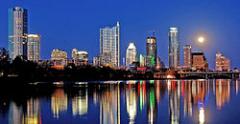
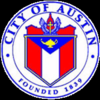
Austin (/ËnÉastɨn/ or /ËnÉeËastɨn/) is the capital of the U.S. state of Texas and the seat of Travis County. Located in Central Texas on the eastern edge of the American Southwest, Austin is the thirteenth most populous city in the United States of America and the fourth most populous city in the state of Texas. It was the third-fastest-growing large city in the nation from 2000 to 2006. Austin has a population of 820,611 (2011 U.S. Census). The city is the cultural and economic center of the Austin aeRound Rock aeSan Marcos metropolitan area, which had an estimated population 1,783,519 (2011 U.S. Census), making it the 34th-largest metropolitan statistical area in the United States and the fourth-largest in Texas.
In the 1830s, pioneers began to settle the area in central Austin along the Colorado River. After Republic of Texas Vice President Mirabeau B. Lamar visited the area during a buffalo-hunting expedition between 1837 and 1838, he proposed that the republic's capital then located in Houston, Texas, be relocated to the area situated on the north bank of the Colorado River near the present-day Ann W. Richards Congress Avenue Bridge. In 1839, the site was officially chosen as the republic's new capital (the republic's seventh and final location) and was incorporated under the name, Waterloo. Shortly thereafter, the name was changed to Austin in honor of Stephen F. Austin, the "Father of Texas" and the republic's first secretary of state.
The city grew throughout the 19th century and became a center for government and education with the construction of the Texas State Capitol and the University of Texas at Austin. After a lull in growth from the Great Depression, Austin resumed its development into a major city in the 1980s and emerged as a center for technology and business. A number of Fortune 500 companies have headquarters or regional offices in Austin including Advanced Micro Devices, Apple, Google, IBM, Intel, Texas Instruments, 3M, and Whole Foods Market. Dell's worldwide headquarters is located in nearby Round Rock, a suburb of Austin.
Residents of Austin are known as "Austinites". They include a diverse mix of government employees (e.g., university faculty & staff, law enforcement, political staffers); foreign and domestic college students; musicians; high-tech workers; blue-collar workers and businesspeople. The city is home to development centers for many technology corporations; it adopted the "Silicon Hills" nickname in the 1990s. However, the current official slogan promotes Austin as "The Live Music Capital of the World", a reference to the many musicians and live music venues within the area, and the long-running PBS TV concert series Austin City Limits. In recent years, some Austinites have also adopted the unofficial slogan "Keep Austin Weird". This interpretation of the classic, "Texas-style" sense of independence refers to: the traditional and proudly eclectic, liberal lifestyles of many Austin residents; a desire to protect small, unique, local businesses from being overrun by large corporations; and, as a reaction to the perceived rise of conservative influences within the community. In the late 1800s, Austin also became known as the City of the "Violet Crown" for the wintertime violet glow of color across the hills just after sunset. Even today, many Austin businesses use the term "violet crown" in their name. Austin is known as a "clean air city" for the city's stringent no-smoking ordinances that apply to all public places and buildings, and all restaurants.
Austin, Travis County, and Williamson County have been the site of human habitation since at least 9,200 BC. The earliest known inhabitants of the area lived during the late Pleistocene (Ice Age) and are linked to the Clovis culture around 9,200 BC (11,200 years ago), based on evidence found throughout the area and documented at the much-studied Gault Site, midway between Georgetown and Fort Hood.
When settlers first arrived from Europe, the area was inhabited by the Tonkawa tribe, and the Comanches and Lipan Apaches were known to travel through the area as well. Spanish explorers, including the Espinosa-Olivares-Aguirre expedition, traveled through the area for centuries, though few permanent settlements were created for some time. In 1730, three missions from East Texas were combined and reestablished as one mission on the south side of the Colorado River, in what is now Zilker Park, in Austin. The mission was in this area for only about seven months, and then was moved to San Antonio de Bexar and split into three missions. In the mid-18th century, the San Xavier missions were located along the Colorado River, in what is now western Milam County, to facilitate exploration.
Early in the 19th century, Spanish forts were established in what are now Bastrop and San Marcos. Following the independence of Mexico, new settlements were established in Central Texas, but growth in the region was stagnant because of conflicts with the regional Native Americans.
In 1835 ae1836, Texans fought and won independence from Mexico. Texas thus became its own independent country with its own president, congress, and monetary system. In 1839, the Texas Congress formed a commission to seek a site for a new capital to be named for Stephen F. Austin. Mirabeau B. Lamar, second president of the newly formed Republic of Texas, advised the commissioners to investigate the area named Waterloo, noting the area's hills, waterways, and pleasant surroundings. Waterloo was selected and the name Austin was chosen as the town's new name. The name Austin is considered to be derived from Augustine, a variant of Augustus. The location was seen as a convenient crossroads for trade routes between Santa Fe and Galveston Bay, as well as routes between northern Mexico and the Red River. Austin is also the site where the southern leg of the Chisholm Trail leads to the Colorado River.
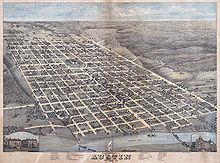
Edwin Waller was picked by Lamar to survey the village and draft a plan laying out the new capital. The original site was narrowed to 640 acres (259 ha) that fronted the Colorado River between two creeks, Shoal Creek and Waller Creek, which was later named in his honor. The 14-block grid plan was bisected by a broad north-south thoroughfare, Congress Avenue, running up from the river to Capital Square, where the new Texas State Capitol was to be constructed. A temporary one-story capitol was erected on the corner of Colorado and 8th Streets. On August 1, 1839, the first auction of 217 out of 306 lots total was held. The grid plan Waller designed and surveyed now forms the basis of downtown Austin.
In 1840, a series of conflicts between the Texas Rangers and the Comanches, known as the Council House Fight and the Battle of Plum Creek, finally pushed the Comanches westward, mostly ending conflicts in Central Texas. Settlement in the area began to expand quickly. Travis County was established in 1840, and the surrounding counties were mostly established within the next two decades.
Initially, the new capital thrived. But Lamar's political enemy, Sam Houston, used two Mexican army incursions to San Antonio as an excuse to move the government. Sam Houston fought bitterly against Lamar aos decision to establish the capital in such a remote wilderness. The men and women who traveled mainly from Houston to conduct government business were intensely disappointed as well. By 1840 the population had risen to 856 of whom nearly half fled from Austin when Congress recessed. The resident Black population listed in January of this same year was 176. The fear of Austin aos proximity to the Indians and Mexico, which still considered Texas a part of their land, created an immense motive for Sam Houston, the first and third President of the Republic of Texas, to relocate the capital once again in 1841. Upon threats of Mexican troops in Texas, Houston raided the Land Office to transfer all official documents to Houston for safe keeping in what was later known as the Archive War, but the people of Austin would not allow this unaccompanied decision to be executed. The documents stayed, but the capital would temporarily move from Austin to Houston to Washington-on-the-Brazos. Without the governmental body, Austin aos population declined to an alarming low of only a few hundred people throughout the early 1840s. The voting by the fourth President of the Republic, Anson Jones, and Congress, who reconvened in Austin in 1845, settled the issue to keep Austin the seat of government as well as annex the Republic of Texas into the United States.
In 1860, 38% of Travis County residents were slaves. In 1861, with the outbreak of the American Civil War, voters in Austin and other Central Texas communities voted against secession. However, as the war progressed and fears of attack by Union forces increased, Austin contributed hundreds of men to the Confederate forces. The African American population of Austin swelled dramatically after the enforcement of the Emancipation Proclamation in Texas by Union General Gordon Granger at Galveston in an event commemorated as Juneteenth. Black communities such as Wheatville, Pleasant Hill, and Clarksville were established with Clarksville being the oldest surviving freedomtown aa the original post-Civil War settlements founded by former African-American slaves aa west of the Mississippi River. In 1870, blacks made up 36.5% of Austin's population. The postwar period saw dramatic population and economic growth. The opening of the Houston and Texas Central Railway (H&TC) in 1871, turned Austin into the major trading center for the region with the ability to transport both cotton and cattle. The Missouri, Kansas, and Texas (MKT) line followed close behind. Austin was also the terminus of the southernmost leg of the Chisholm Trail and "drovers" pushed cattle north to the railroad. Cotton was one of the few crops produced locally for export and a cotton gin engine was located downtown near the trains for "ginning" cotton of its seeds and turning the product into bales for shipment. As other new railroads were built through the region in 1870s, however, Austin began to lose its primacy in trade to the surrounding communities. In addition, the areas east of Austin took over cattle and cotton production from Austin, especially in towns like Hutto and Taylor that sit over the blackland prairie, with its deep, rich soils for producing cotton and hay.
In September 1881, Austin public schools held their first classes. The same year, Tillotson Collegiate and Normal Institute (now part of Huston-Tillotson University) opened its doors. The University of Texas at Austin held its first classes in 1883, although classes had been held in the original wooden state Capitol for four years before.
During the 1880s, Austin gained new prominence as the state capitol building was completed in 1888 and claimed as the seventh largest building in the world. In the late 19th century, Austin expanded its city limits to more than three times its former area, and the first granite dam was built on the Colorado River to power a new street car line and the new "moon towers." Unfortunately the first dam washed away in a flood on April 6, 1909. It was finally replaced in 1940 by a hollow concrete dam that formed Lake McDonald (now called Lake Austin) and which has withstood all floods since. In addition, the much larger Mansfield Dam was built by the LCRA upstream of Austin to form the flood-control lake, Lake Travis. In the early 20th century, the Texas Oil Boom took hold, creating tremendous economic opportunities in Southeast Texas and North Texas. The growth generated by this boom largely passed by Austin at first, with the city slipping from fourth largest to 10th largest in Texas between 1880 and 1920.
In the 1920s and 1930s Austin launched a series of civic development and beautification projects that created much of the city's infrastructure and many of its parks. In addition, the state legislature established the Lower Colorado River Authority that, along with the City of Austin, created the system of dams along the Colorado River to form the Highland Lakes. These projects were enabled in large part because the Public Works Administration provided Austin with greater funding for municipal construction projects than other Texas cities.
After the mid-20th century, Austin became established as one of Texas' major metropolitan centers. In 1970, the Census Bureau reported Austin's population as 14.5% Hispanic, 11.9% black, and 73.4% non-Hispanic white. In the late 20th century, Austin emerged as an important high tech center for semiconductors and software. The University of Texas at Austin emerged as a major university.
The 1970s saw Austin's emergence in the national music scene, with local artists such as Willie Nelson, Asleep at the Wheel, and Stevie Ray Vaughan and iconic music venues such as the Armadillo World Headquarters. Over time, the long-running television program Austin City Limits, its namesake Austin City Limits Festival, and the South by Southwest music festival solidified the city's place in the music industry.
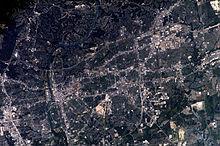
Austin is located in Central Texas, along the Balcones Escarpment and Interstate 35, northwest of Houston. It is also 80 miles northeast of its neighboring city, San Antonio. Its elevation varies from 425 feet (130 m) to approximately 1,000 feet (305 m) above sea level. As of 2010, the city occupies a total area of 271.8 square miles (704 km2). Approximately 6.9 square miles (18 km2) of this area is water.
Austin is situated on the Colorado River, with three man-made (artificial) lakes within the city limits: Lady Bird Lake (formerly known as Town Lake), Lake Austin (both created by dams along the Colorado River), and Lake Walter E. Long that is partly used for cooling water for the Decker Power Plant. Mansfield Dam and the foot of Lake Travis are located within the city's limits. Lady Bird Lake, Lake Austin, and Lake Travis are each on the Colorado River. As a result of its straddling the Balcones Fault, the eastern part of the city is flat, with heavy clay and loam soils, whereas, the western part and western suburbs consist of rolling hills on the edge of the Texas Hill Country. Because the hills to the west are primarily limestone rock with a thin covering of topsoil, portions of the city are frequently subjected to flash floods from the runoff caused by thunderstorms. To help control this runoff and to generate hydroelectric power, the Lower Colorado River Authority operates a series of dams that form the Texas Highland Lakes. The lakes also provide venues for boating, swimming, and other forms of recreation within several parks on the lake shores.
Austin is located at the intersection of four major ecological regions, and is consequently a temperate-to-hot green oasis with a highly variable climate having some characteristics of the desert, the tropics, and a wetter climate. The area is very diverse ecologically and biologically, and is home to a variety of animals and plants. Notably, the area is home to many types of wildflowers that blossom throughout the year but especially in the spring, including the popular bluebonnets, some planted in an effort by "Lady Bird" Johnson, wife of former President Lyndon Johnson.
A popular point of prominence in Austin is Mount Bonnell. At about 780 feet (238 m) above sea level, it is a natural limestone formation overlooking Lake Austin on the Colorado River, with an observation deck about 200 feet (61 m) below its summit.
The soils of Austin range from shallow, gravelly clay loams over limestone in the western outskirts to deep, fine sandy loams, silty clay loams, silty clays or clays in the city's eastern part. Some of the clays have pronounced shrink-swell properties and are difficult to work under most moisture conditions. Many of Austin's soils, especially the clay-rich types, are slightly to moderately alkaline and have free calcium carbonate.
Austin has a humid subtropical climate (Koppen Cfa), characterized by hot summers with prevailing humid winds from the Gulf of Mexico and mild winters. On average, Austin receives 33.6 inches (853.4 mm) of rain per year, with most of the precipitation in the spring, and a secondary maximum in the fall. During springtime, severe thunderstorms sometimes occur, though tornadoes are rare in the city. Austin is usually at least partially sunny, receiving nearly 2650 hours, or 60.3% of the possible total, of bright sunshine per year.
Austin summers are usually hot, with average July and August highs in the high-90s °F (34 ae36 °C). Highs exceed 90 °F (32.2 °C) on 109 days per year, and 100 °F (37.8 °C) on 12. The highest recorded temperature was 112 °F (44 °C) occurring on September 5, 2000 and August 28, 2011
Winters in Austin are mild and relatively dry. For the entire year, Austin averages 88 days below 45 °F (7.2 °C) and 18 days when the minimum temperature falls below freezing. The lowest recorded temperature was na2 °F ( na19 °C) on January 31, 1949. About every two years or so, Austin experiences an ice storm that freezes roads over and affects much of the city for 24 to 48 hours. Snowfall is rare in Austin; a 3-inch (7.6 cm) snowstorm brought the city to a near standstill in 1985.
Monthly averages for Austin's weather data are shown in a graphical format to the right, and in a more detailed tabular format below.
From October 2010 through September 2011, Austin had the least rainfall since the 1950s. This was a result of La NiR±a conditions in the eastern Pacific Ocean where water was significantly cooler than normal. Dr. David Brown, a regional official with the National Oceanic and Atmospheric Administration, has explained that "these kinds of droughts will have effects that are even more extreme in the future, given a warming and drying regional climate."
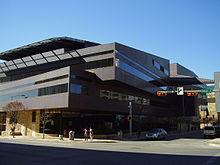
Austin is administered by a city council of seven members, each of them elected at large. The council is composed of six council members, and by an elected mayor, accompanied by a hired city manager under the manager-council system of municipal governance. Council and mayoral elections are non-partisan, with a runoff in case there is no majority winner. Austin remains an anomaly among large Texas cities in that council members are elected on an at-large basis by all voters, as opposed to elections by districts.
Austin formerly operated its city hall at 128 West 8th Street. Antoine Predock and Cotera Kolar Negrete & Reed Architects designed a new city hall building, which was intended to reflect what The Dallas Morning News referred to as a "crazy-quilt vitality, that embraces everything from country music to environmental protests and high-tech swagger." The new city hall, built from recycled materials, has solar panels in its garage. The city hall, at 301 West Second Street, opened in November 2004. The current[update] mayor of Austin is Lee Leffingwell. His second term ends in 2015.
Law enforcement in Austin is provided by the Austin Police Department, except for state government buildings, which are patrolled by the Texas Department of Public Safety.
Fire protection within the city limits is provided by the Austin Fire Department, while the surrounding county is divided into twelve geographical areas known as Emergency Services Districts, which are covered by separate regional fire departments. Emergency Medical Services are provided for the whole county by "Austin-Travis County Emergency Medical Services".
The Texas Department of Transportation operates the Austin District Office in Austin.
The Texas Department of Criminal Justice (TDCJ) operates the Austin I and Austin II district parole offices in Austin.
The United States Postal Service operates several post offices in Austin.
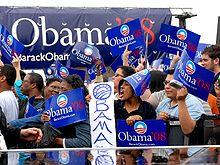
Austin is known as an enclave of liberal politics in a generally conservative state aeso much so, that the city is sometimes sarcastically called the "People's Republic of Austin" by residents of other parts of Texas, and conservatives in the Texas Legislature.
As a result of the major party realignment that began in the 1970s, central Austin became a stronghold of the Democratic Party, while the suburbs tend to vote Republican. Opponents characterized the resulting district layout as excessively partisan gerrymandering, and the plan was challenged in court on this basis by Democratic and minority activists; of note, the Supreme Court of the United States has never struck down a redistricting plan for being excessively partisan. The plan was subsequently upheld by a three-judge federal panel in late 2003, and on June 28, 2006, the matter was largely settled when the Supreme Court in a 7 ae2 decision upheld the entire congressional redistricting plan with the exception of a Hispanic-majority district in southwest Texas. This later affected Austin's districting, as U.S. Rep. Lloyd Doggett's district (U.S. Congressional District 25) was found to be insufficiently compact to compensate for the reduced minority influence in the southwest district and so was redrawn so that it now takes in most of southeastern Travis County and several counties to its south and east.
Overall, the city is a blend of downtown liberalism and suburban conservatism but leans to the political left as a whole. In 2003, the city adopted a resolution against the USA PATRIOT Act that reaffirmed constitutionally guaranteed rights. In the 2004 presidential election, Senator John Kerry won a substantial majority of the votes in Travis County. Of Austin's six state legislative districts, three are strongly Democratic and three are swing districts, two of which are held by Democrats and one of which is held by a Republican. However, two of its three congressional districts (the 10th and the 21st) are presently held by Republicans, with only the 25th held by a Democrat. This is largely due to the 2003 redistricting, which left downtown Austin without an exclusive congressional seat of its own. Travis County was also the only county in Texas to reject Texas Constitutional Amendment Proposition 2 that effectively outlawed gay marriage and status equal or similar to it and did so by a wide margin (40% for, 60% against).
Austin is also an active area for the Libertarian Party.
Two of the candidates for president in the 2004 race call Austin home. Michael Badnarik, the Libertarian Party candidate, and David Cobb of the Green Party both have lived in Austin. During the run up to the election in November, a presidential debate was held at the University of Texas at Austin student union involving the two minor party candidates. While the Commission on Presidential Debates only invites Democrats and Republicans to participate in televised debates, the debate at UT was open to all presidential candidates. Austin also hosted one of the last presidential debates between Barack Obama and Hillary Clinton during their heated race for the Democratic nomination in 2008.
The distinguishing political movement of Austin politics has been that of the environmental movement, which spawned the parallel neighborhood movement, then the more recent conservationist movement (as typified by the Hill Country Conservancy), and eventually the current on-going debate about "sense of place" and preserving the Austin quality of life. Much of the so-called environmental movement has matured into a debate on issues related to saving and creating an Austin "sense of place."
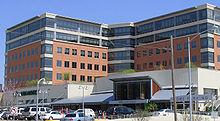
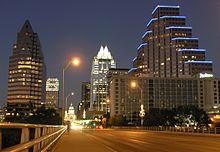
Austin is the anchor city of the Austin-Round Rock-San Marcos MSA, which had a Gross Domestic Product of $86 billion in 2010. Austin is considered to be a major center for high tech. Thousands of graduates each year from the engineering and computer science programs at the University of Texas at Austin provide a steady source of employees that help to fuel Austin's technology and defense industry sectors. The region's rapid growth has led Forbes to rank the Austin metropolitan area number one among all big cities for jobs for 2012 in their annual survey. The metro Austin area has much lower housing costs than the San Francisco Bay Area's Silicon Valley, but much higher housing costs than many parts of rural Texas. As a result of the high concentration of high-tech companies in the region, Austin was strongly affected by the dot-com boom in the late 1990s and subsequent bust. Austin's largest employers include the Austin Independent School District, the City of Austin, Dell, the U.S. Federal Government, Freescale Semiconductor (spun off from Motorola in 2004), IBM, St. David's Healthcare Partnership, Seton Family of Hospitals, the State of Texas, Texas State University aeSan Marcos, and the University of Texas at Austin. Other high-tech companies with operations in Austin include Nvidia, 3M, Apple, Hewlett-Packard, Google, AMD, Applied Materials, Cirrus Logic, Cisco Systems, Flextronics, eBay/PayPal, Bioware, Blizzard Entertainment, Hoover's, Intel Corporation, National Instruments, Samsung Group, Buffalo Technology, Silicon Laboratories, Xerox, Oracle, Hostgator, HomeAway, and United Devices. In 2010, Facebook accepted a grant to build a downtown office that could bring as many as 200 jobs to the city. The proliferation of technology companies has led to the region's nickname, "the Silicon Hills", and spurred development that greatly expanded the city. The concentration of high-tech companies has led the former American Airlines flight between Austin and San Jose, California to be dubbed the "nerd bird."
Austin is also emerging as a hub for pharmaceutical and biotechnology companies; the city is home to about 85 of them. The city was ranked by the Milken Institute as the No.12 biotech and life science center in the United States. Companies such as Hospira, Pharmaceutical Product Development, and ArthroCare are located there.
Whole Foods Market (often called just "Whole Foods") is an upscale, international grocery store chain specializing in fresh and packaged food products aemany having an organic-/local-/"natural"-theme. It was founded and is headquartered in Austin.
Other companies based in Austin include Temple-Inland, Keller Williams Realty, GSD&M Idea City, Golfsmith, Forestar Group and EZCorp.
An Online Trading Academy office and center is also located in Austin.
In addition to national and global corporations, Austin features a strong network of independent, unique, locally owned firms and organizations.

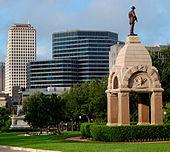
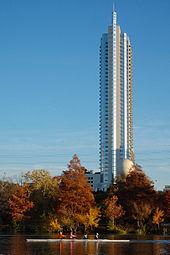
Buildings that make up most of Austin's skyline are modest in height and somewhat spread out. The latter characteristic is partly due to a restriction that preserves the view of the Texas State Capitol building from various locations around Austin (known as the Capitol View Corridor). However, many new highrise towers have been constructed and the downtown area is looking more modern and dense. The city's tallest building, The Austonian, was topped out on September 17, 2009. Austin is currently undergoing a skyscraper boom, which includes recent construction on the now complete 360 Condominiums at 563 feet (172 m), Spring (condominiums),the Austonian at 683 feet (208 m), and several others that are mainly for residential use. By 2015, the Frost Bank Tower could be the only skyscraper built before 2005 to remain in the ten tallest buildings in the city.
At night, parts of Austin are lighted by "artificial moonlight" from Moonlight Towers built to illuminate the central part of the city. The 165-foot (50 m) moonlight towers were built in the late 19th century and are now recognized as historic landmarks. Only 15 of the 31 original innovative towers remain standing in Austin, and none remain in any of the other cities where they were installed. The towers are featured in the 1993 film Dazed and Confused.
The central business district of the city is home to some of the tallest condo towers in the state, with the Austonian Condos topping out at 56 floors and the 360 Condos at 44 floors. The 360 Tower and the Four Seasons Condos are condo towers in Austin, opened in early 2008. Former Mayor Will Wynn set out a goal for having up to 25,000 people living Downtown by 2015, and the city provided incentives for building residential units in the urban core. Because of this, the city has been driven to increase density in Austin's urban core. The skyline has drastically changed in recent years, and the residential real estate market has remained relatively strong. Downtown growth has been aided by the presence of a popular live music and nightlife scene, museums, restaurants, and Lady Bird Lake, considered one of the city's best recreational spots. The 2nd Street District consists of several new residential projects, restaurants, coffee shops, record stores, upscale boutiques and museums, and the Austin City Hall. Across 2nd Street from Austin City Hall is the newly re-created TV set for the long-running PBS program Austin City Limits,[100] which is housed beneath the new 478 feet (146 m) W Hotel.[101] The new Austin City Limits location also presents national and local live music performances unrelated to the television show such as recent performances by story-teller Garrison Keillor, and music groups Return to Forever and George Thorogood. South by Southwest (SXSW)[102] is hosted downtown and is one of the largest music festivals in the United States, with more than 2,000 performers playing in more than 90 venues around Downtown Austin over four days, in March. Though it is an industry-based event, SXSW Music links locally with events such as the annual Austin Music Awards show. SXSW is the highest revenue-producing special event for the Austin economy, with an estimated economic impact of at least $167 million in 2010.[103]
According to the 2010 Census,[104] the racial composition of Austin is:
As of the census of 2000, there were 656,562 people, 265,649 households, and 141,590 families residing in the city (roughly comparable in size to San Francisco, Leeds, UK; and Ottawa). The population density was 2,610.4 people per square mile (1,007.9/km ²). There were 276,842 housing units at an average density of 1,100.7 per square mile (425.0/km ²). There were 265,648 households out of which 26.8% had children under the age of 18 living with them, 38.1% were married couples living together, 10.8% had a female householder with no husband present, and 46.7% were non-families. 32.8% of all households were made up of individuals and 4.6% had someone living alone who was 65 years of age or older. The average household size was 2.40 and the average family size was 3.14.
In the city the population was spread out with 22.5% under the age of 18, 16.6% from 18 to 24, 37.1% from 25 to 44, 17.1% from 45 to 64, and 6.7% who were 65 years of age or older. The median age was 30 years. For every 100 females there were 105.8 males.
The median income for a household in the city was $42,689, and the median income for a family was $54,091. Males had a median income of $35,545 vs. $30,046 for females. The per capita income for the city was $24,163. About 9.1% of families and 14.4% of the population were below the poverty line, including 16.5% of those under age 18 and 8.7% of those age 65 or over. The median house price was $185,906 in 2009, and it has increased every year since 2004.[dated info][105]
In July 2009, the U.S. Census Bureau reported that the Austin aeRound Rock-San Marcos metropolitan area had 1,705,075 people (roughly comparable to the San Jose, California area in the U.S.; the West Yorkshire area in the UK; and the Marseille area in France).
"Keep Austin Weird" has become a local motto in recent years, featured on bumper stickers and t-shirts. This motto has not only been used in promoting Austin's eccentricity and diversity, but is also meant to bolster support of local independent businesses. According to the 2010 book, Weird City, the phrase was begun by a local Austin Community College librarian, Red Wassenich, and his wife, Karen Pavelka, who were concerned about Austin's "rapid descent into commercialism and over-development."[106] The slogan has been interpreted many ways since its inception, but remains an important symbol for many Austinites who wish to voice concerns over rapid growth and irresponsible development. Austin has a long history of vocal citizen resistance to development projects perceived to degrade the environment, or to threaten the natural and cultural landscapes.[107]
According to the Nielsen Company, adults in Austin read and contribute to blogs more than those in any other U.S. metropolitan area.[108] Austin residents have the highest internet usage in all of Texas.[108] Austin was selected as the No. 2 Best Big City in "Best Places to Live" by Money magazine in 2006, and No. 3 in 2009, and also the "Greenest City in America" by MSN.[109][110] According to Travel & Leisure magazine, Austin ranks No. 1 on the list of cities with the best people, referring to the personalities and attributes of the citizens.[111]
SoCo is a shopping district stretching down South Congress Avenue from Downtown. This area is home to coffee shops, eccentric stores, restaurants, food trucks, trailers and festivals. It prides itself on "Keeping Austin Weird", especially with development in the surrounding area(s).
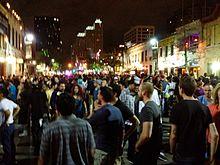
The O. Henry House Museum hosts the annual O. Henry Pun Off, a pun contest where the contestants exhibit wit. Other annual events include Eeyore's Birthday Party, Spamarama, the Austin Reggae Festival and Art City Austin in April, East Austin Studio Tour in November, and Carnaval Brasileiro in February. Sixth Street features annual festivals such as the Pecan Street Festival and Halloween night. The three-day Austin City Limits Music Festival has been held in Zilker Park every year since 2002. Every year around the end of March and the beginning of April, Austin is home to "Texas Relay Weekend."
Austin's Zilker Park Tree is a Christmas display made of lights strung from the top of a Moonlight tower in Zilker Park. The Zilker Tree is lit in December along with the "Trail of Lights", an Austin Christmas tradition. In 2010, the Trail of Lights was canceled due to budget problems, but the city says they hope to have finances for the trail next year.
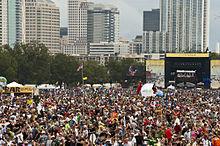
As Austin's official slogan is The Live Music Capital of the World, the city has a vibrant live music scene with more music venues per capita than any other U.S. city. Austin's music revolves around the many nightclubs on 6th Street and an annual film/music/interactive festival known as South by Southwest (SXSW). The longest-running concert music program on American television, Austin City Limits, is recorded at ACL Live at The Moody Theater. Austin City Limits and C3 Presents produce the Austin City Limits Music Festival, an annual music and art festival held at Zilker Park in Austin. Other music events include the Urban Music Festival, Fun Fun Fun Fest, Chaos In Tejas and Old Settler's Music Festival. Austin Lyric Opera performs multiple operas each year (including the 2007 opening of Philip Glass's Waiting for the Barbarians, written by University of Texas at Austin alumnus J. M. Coetzee).[112] The Austin Symphony Orchestra performs a range of classical, pop and family performances and is led by Music Director and Conductor Peter Bay.
Austin hosts the annual Austin Film Festival, which draws films of many different types from all over the world. In 2004 the city was first in MovieMaker Magazine's annual top ten cities to live and make movies. The 2007 South by Southwest (SXSW) festival included Pete Townshend, Iggy Pop, Tom Morello, and Rickie Lee Jones.
Austin has been the location for a number of motion pictures, partly due to the influence of The University of Texas at Austin Department of Radio-Television-Film. Films produced in Austin include The Texas Chain Saw Massacre (1974) Man of the House, Secondhand Lions, Waking Life, Spy Kids, Dazed and Confused, Wild Texas Wind, Office Space, The Life of David Gale, Miss Congeniality, Doubting Thomas, Slacker, Idiocracy, The New Guy, Hope Floats, The Alamo, Blank Check, The Wendall Baker Story, School of Rock, A Slipping-Down Life, A Scanner Darkly, Saturday Morning Massacre, and most recently, the Coen Brothers' True Grit, Grindhouse, Machete, How To Eat Fried Worms and Bandslam. In order to draw future film projects to the area, the Austin Film Society has converted several airplane hangars from the former Mueller Airport into filmmaking center Austin Studios. Projects that have used facilities at Austin Studios include music videos by The Flaming Lips and feature films such as 25th Hour and Sin City. Austin also hosted the MTV series, The Real World: Austin in 2005. The film review websites Spill.com and Ain't It Cool News are based in Austin. Rooster Teeth Productions, creator of popular web series such as Red vs. Blue and Immersion, is also located in Austin.
Austin's main daily newspaper is the Austin American-Statesman. The Austin Chronicle is Austin's alternative weekly, while The Daily Texan is the student newspaper of the University of Texas at Austin. Austin's business newspaper is the weekly Austin Business Journal. Austin also has numerous smaller special interest or sub-regional newspapers such as the Oak Hill Gazette, Westlake Picayune, Hill Country News, Round Rock Leader, NOKOA, and The Villager among others. Texas Monthly, a major regional magazine, is also headquartered in Austin. The Texas Observer, a muckraking biweekly political magazine, has been based in Austin for over five decades. The weekly Community Impact Newspaper newspaper published by John Garrett, former publisher of the Austin Business Journal has five regional editions and is delivered to every house and business within certain zip codes and all of the news is specific to those zip codes.[113] The most recent entrant on the Austin news scene is The Texas Tribune, an on-line publication focused on Texas and Austin politics.[114] The Tribune is "user-supported" through donations, a business model similar to public radio.[115] The Editor is Evan Smith, former Editor of Texas Monthly. Smith co-founded the Texas Tribune, a nonprofit, non-partisan public media organization, with Austin venture capitalist John Thornton and veteran journalist Ross Ramsey.[114][116]
Commercial radio stations include KASE-FM (country), KVET (sports), KVET-FM (country), KKMJ-FM (adult contemporary), KLBJ (talk), KLBJ-FM (classic rock), KLGO (Christian talk), KFMK (contemporary Christian), KOKE-FM (progressive country) and KPEZ (rhythmic contemporary). KUT is the leading public radio station in Texas and produces the majority of its content locally.[117] KOOP (FM) is a volunteer-run radio station with more than 60 locally produced programs.[118] KVRX is the student-run college radio station of the University of Texas at Austin with a focus on local and non-mainstream music and community programming.[119] Other listener-supported stations include KAZI (urban contemporary), and KMFA (classical)
Network television stations (affiliations in parentheses) include KTBC (Fox), KVUE (ABC), KXAN (NBC), KEYE-TV (CBS), KLRU (PBS), KNVA (The CW), KBVO (My Network TV), and KAKW (Univision). KLRU produces several award winning locally produced programs such as Austin City Limits.[120] Also, subscribers to Time Warner Cable receive a 24-hour local news station, News 8 Austin. In some parts of Austin, Time Warner has cable competition from Grande Communications.
Austin has a strong theater culture, with dozens of itinerant and resident companies producing a variety of work. The city also has live performance theater venues such as the Zachary Scott Theatre Center, Vortex Repertory Company, Salvage Vanguard Theater, Rude Mechanicals' the Off Center, Austin Playhouse, Scottish Rite Children's Theater, Hyde Park Theatre, the Blue Theater, the Hideout Theater, and Esther's Follies.[121] The Victory Grill was a renowned venue on the Chitlin' circuit.[122] Public art and performances in the parks and on bridges are popular. Austin hosts the Fuse Box Festival each April featuring international, leading-edge theater artists.[123]
The Paramount Theatre, opened in downtown Austin in 1915, contributes to Austin's theater and film culture, showing classic films throughout the summer and hosting regional premieres for films such as Miss Congeniality.[124] The Zilker Park Summer Musical is a long-running outdoor musical.[125]
The Long Center for the Performing Arts is a 2,300 seat theater built partly with materials reused from the old Lester E. Palmer Auditorium.
Ballet Austin is the fourth largest ballet academy in the country.[126] Each year Ballet Austin's twenty member professional company performs ballets from a wide variety of choreographers, including their international award winning artistic director, Stephen Mills. The city is also home to the Ballet East Dance Company, a modern dance ensemble, and the Tapestry Dance Company which performs a variety of dance genres.
The Austin improv comedy scene has several theaters: ColdTowne Theater, The Hideout Theater, The New Movement Theater, and Salvage Vanguard Theater. Austin also hosts the Out of Bounds Improv Festival, which draws comedic artists in all disciplines to Austin.
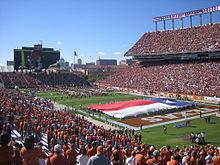
Austin is the largest city in the United States without a club in a major professional sports league.[127] Many Austinites support the athletic programs of the University of Texas at Austin known as the Texas Longhorns. During the 2005 ae06 academic term, Longhorns football team was named the NCAA Division I FBS National Football Champion and Longhorns baseball team won the College World Series.[128][129] The Texas Longhorns play home games in the state's second-largest sports stadium, Darrell K Royal-Texas Memorial Stadium, seating over 101,000 fans.[130] Baseball games are played at UFCU Disch aeFalk Field which underwent renovation in 1996 with an increased capacity to 6,756 seats plus 11 stadium suites.
Minor-league professional sports came to Austin in 1996, when the Austin Ice Bats began playing at the Travis County Expo Center.[131] Since then, the Austin Ice Bats have been replaced by the Texas Stars[132] of the American Hockey League, and many other teams have come to Austin including the Austin Toros of the NBA Development League, and the Texas Stars. Austin is home to the 2010 U.S. Youth Soccer U19 Girls National Champion club Lonestar Soccer Club.
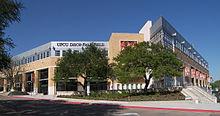
Natural features like the bicycle-friendly Texas Hill Country, limestone rock formations, and generally mild climate work with the centrally located Lady Bird Lake Hike and Bike Trail, and local pools like Barton Springs to make Austin the home of several endurance and multi-sport races and communities. The Capitol 10,000 is the largest 10 K race in Texas, and approximately fifth largest in the United States.[133] The Austin Marathon has been run in the city every year since 1992. The Austin-founded American Swimming Association hosts an open water swimming event, the Cap 2 K, and other closed-course, open water, and cable swim races around town. Austin is also the hometown of several cycling groups and the seven-time Tour de France champion cyclist[134] Lance Armstrong, as well as environmentally and economically minded bicycle commuters. Combining these three disciplines is a growing crop of triathlons, including the Capital of Texas Triathlon held every Memorial Day on and around Lady Bird Lake, Auditorium Shores, and Downtown Austin.[135]
Austin is known as a major Disc Golf city as well, with 11 established courses and over 50 courses within driving distance.
In June 2010 it was announced by the Formula One chief executive Bernie Ecclestone that the Austin area would host the Formula One, United States Grand Prix, from 2012 until 2021. The effort was aided by State Comptroller Susan Combs. The State has pledged to put up $25 million in public funds annually for 10 years to pay the sanctioning fees for the race.[136] The event was last held in 2007 at the Indianapolis Motor Speedway.[137] A Formula One circuit will need to be built at an estimated cost of $250 to $300 million, paid for by private investors, and is expected to be located just east of the Austin Bergstrom International Airport. The Austin investor group is headed by Tavo Hellmund,[138] President of Full Throttle Productions, LP. Hellmund, of Austin, is himself a former race car owner and driver.[139] Circuit of the Americas will also play host to MotoGP World Championships from 2013.
Austin is also considered the birthplace of all-women's flat track roller derby.[140] In 2003, the Texas Rollergirls formed as the first league to play modern flat-track roller derby[141] and, in 2005, were instrumental in the rule-setting and track design used by the Women's Flat Track Derby Association.[142]
Museums in Austin include the Texas Memorial Museum, the Blanton Museum of Art (reopened in 2006), the Bob Bullock Texas State History Museum across the street (which opened in 2000), the Austin Museum of Art (AMOA), and the galleries at the Harry Ransom Center. The Texas State Capitol itself is also a major tourist attraction. The Driskill Hotel built in 1886, and located at 6th and Brazos, was finished just before the construction of the Capitol building. Sixth Street is a musical hub for the city. The Enchanted Forest, a multi-acre outdoor music, art, and performance art space in South Austin hosts events such as fire-dancing and circus-like-acts.[143] Austin is also home to the Lyndon Baines Johnson Library and Museum, which houses documents and artifacts related to the Johnson administration, including LBJ's limousine and a recreation of the Oval Office.
Locally produced art is featured at the South Austin Museum of Popular Culture. The Mexic-Arte Museum is a Latin American art museum founded in 1983. Austin is also home to the O. Henry House Museum, residence of O. Henry from 1893 ae1895. Farmers markets are popular attractions, providing a variety of locally grown and often organic goods.[144]
Austin is also "weird" for its many statues and landmarks, such as the Hyde Park Bar & Grill fork, the Mangia dinosaur, the Loca Maria lady at Taco Xpress on South Lamar, the 'migrating' pink flamingos on the lawn in front of the Pots and Plants Garden Center, the Hyde Park Gym's giant flexed arm, and Daniel Johnston's Hi, how are you? frog mural.[145]
Austinites often start tours for visitors with a pilgrimage to the statue of Texas blues guitarist Stevie Ray Vaughan on the south shore of Town Lake. The statue's 'shadow' is longer than its height, to symbolize Vaughan's wide influence on electric guitarists.
The Ann W. Richards Congress Avenue Bridge houses the world's largest urban population of Mexican Free-tailed Bats. Starting in March,[146][147] up to 1.5 million bats take up residence inside the bridge's expansion and contraction zones as well as in long horizontal grooves running the length of the bridge's underside, an environment ideally suited for raising their young. Every evening around sunset, the bats emerge in search of insects, an exit visible on weather radar. Watching the bat emergence is an event that is popular with locals and tourists, with more than 100,000 viewers per year. The bats migrate to Mexico each winter.[148]
The Austin Zoo, located in unincorporated western Travis County is a rescue zoo that provides sanctuary to displaced animals from a variety of situations, including those involving neglect.
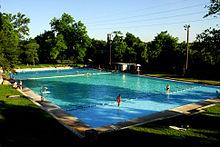
The Austin Parks & Recreation Department received the Excellence in Aquatics award in 1999 and the Gold Medal Awards in 2004 from the National Recreation and Park Association.[149][150] Home to more than 50 public swimming pools, Austin has parks and pools throughout the city. There are several well-known swimming locations. These include Deep Eddy Pool, Texas' oldest man-made swimming pool, and Barton Springs Pool, the nation's largest natural swimming pool in an urban area.[151][152] Barton Springs Pool is spring-fed while Deep Eddy is well-fed. Both range in temperature from about 68.0 °F (20.0 °C) during the winter to about 71.6 °F (22.0 °C) during the summer.[153][154][155] Hippie Hollow Park, a county park situated along Lake Travis, is the only officially sanctioned clothing-optional public park in Texas. Activities include rockclimbing, kayaking, swimming, exploring, and hiking along the greenbelt, a long-spanning area that runs through the city. Zilker Park, a large green area close to downtown, forms part of the greenbelt along the Colorado River. Hamilton Pool is a pool and wildlife park located about 30 minutes from the city.[156]
Of all the people who work in Austin, 73% drive alone, 10% carpool, 6% work from home, 5% take the bus, 2% walk, and 1% bicycle.[157]
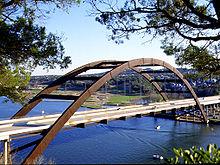
Central Austin lies between two major north-south freeways: Interstate 35 to the east and the Mopac Expressway (Loop 1) to the west. U.S. Highway 183 runs from northwest to southeast, and State Highway 71 crosses the southern part of the city from east to west, completing a rough "box" around central and north-central Austin. Austin is the largest city in the United States to be served by only one Interstate Highway.
U.S. Highway 290 enters Austin from the east and merges into Interstate 35. Its highway designation continues south on I-35 and then becomes part of Highway 71, continuing to the west. Highway 290 splits from Highway 71 in southwest Austin, in an interchange known as "The Y." Highway 71 continues to Brady, Texas, and Highway 290 continues west to intersect Interstate 10 near Junction. Interstate 35 continues south through San Antonio to Laredo on the Texas-Mexico border. Interstate 35 is the highway link to the Dallas-Fort Worth metroplex in northern Texas. There are two links to Houston, Texas (Highway 290 and State Highway 71/Interstate 10). Highway 183 leads northwest of Austin toward Lampasas.
In the mid-1980s, construction was completed on Loop 360, a scenic highway that curves through the hill country from near the 71/Mopac interchange in the south to near the 183/Mopac interchange in the north. The iconic Pennybacker Bridge, also known as the "360 Bridge", crosses Lake Austin to connect the northern and southern portions of Loop 360.
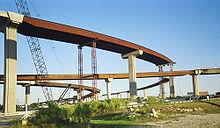
In November 2006, the first segments of State Highway 130 opened, running from south of Austin-Bergstrom International Airport to Interstate 35 just north of Georgetown. Highway 130 connects with Highway 45 in Pflugerville, Texas. State Highway 130 is planned to end at Interstate 10, east of Seguin, about 30 miles (48 km) east-northeast of San Antonio.
State Highway 45 runs east-west from just west of Highway 183 in Cedar Park to 130 inside Pflugerville (just east of Round Rock). A tolled extension of State Highway Loop 1 was also created. A new southeast leg of Highway 45 has recently been completed, connecting US 183 and the current south end of TX-130 to I-35 at the FM 1327/Creedmoor exit near the south end of Austin, near Buda's. The 183A Toll Road opened March 2007, providing a tolled alternative to U.S. 183 through the cities of Leander and Cedar Park. Despite the overwhelming initial opposition to the toll road concept when it was first announced, all three toll roads have improved mobility in and around the Austin area and are significantly exceeding their revenue projections.[158]
Austin's airport is Austin-Bergstrom International Airport (ABIA) (IATA code AUS), located 5 miles (8 km) southeast of the city. The airport is on the site of the former Bergstrom Air Force Base, which was closed in 1993 as part of the Base Realignment and Closure process. Previously, Robert Mueller Municipal Airport was the commercial airport of Austin.
Greyhound Lines operates the Austin Station at 916 East Koenig Lane, just east of Airport Boulevard and adjacent to Highland Mall.[159] Turimex Internacional operates bus service from Austin to Nuevo Laredo and on to many destinations in Mexico. The Turimex station is located at 5012 East 7th Street, near Shady Lane.[160]
The newest bus option for Austinites is Megabus (North America). It offers a limited route, with nice busses and advance tickets starting at $1.[161]
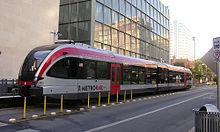
Capital Metropolitan Transportation Authority (Capital Metro) provides public transportation to the city, primarily by bus. Capital Metro is planning to change some routes to "Rapid Lines". The lines will feature 60 ft (18 m) long, train-like high-tech buses. This addition is going to be implemented to help reduce congestion. Capital Metro opened a 32-mile (51 km) commuter rail system known as Capital MetroRail on March 22, 2010.[162] The system was built on existing freight rail lines and will serve downtown Austin, East Austin, North Central Austin, Northwest Austin, and Leander in its first phase. Future expansion could include a line to Manor and another to Round Rock. Capital Metro is also looking into a circulator system of streetcars to connect most of Downtown, the University of Texas at Austin, and the 700-acre (2.8 km2) Mueller Airport Redevelopment. The streetcar system would help connect the new rail line to key destinations in Central Austin. An Amtrak Texas Eagle station is located west of downtown. Segments of the Amtrak route between Austin and San Antonio are under evaluation for a future passenger rail corridor as an alternative to the traffic congestion of Interstate 35. Austin is known as the most bike-friendly city in Texas and has a Silver-level rating from the League of American Bicyclists. Austin is also home to Car2Go, a carsharing program. Austin was chosen as the first city in the western hemisphere to host this company's business, which is based in Germany.
A 2011 study by Walk Score ranked Austin 31st most walkable of fifty largest U.S. cities.[163]
Researchers at Central Connecticut State University ranked Austin the 16th most literate city in the United States for 2008.[164] The Austin Public Library operates the John Henry Faulk Library and various library branches. In addition, the University of Texas at Austin operates the seventh-largest academic library in the nation.[165]
Austin was voted "America's No.1 College Town" by the Travel Channel.[166] Over 43 percent of Austin residents age 25 and over hold a bachelor's degree, while 16 percent hold a graduate degree.[167] As of 2009, greater Austin ranks eighth among metropolitan areas in the United States for bachelor's degree attainment with nearly 39 percent of area residents over 25 holding a bachelor's degree.[168]
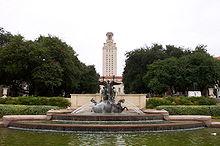
Austin is home to the University of Texas at Austin, the flagship institution of the University of Texas System with over 38,000 undergraduate students and 12,000 graduate students. In 2010, the university was ranked 45th among "National Universities" (13th among public universities) by U.S. News and World Report.[169] UT has annual research expenditures of over $640 million[170] and has the highest-ranked business, engineering, and law programs of any university in the state of Texas.[171][172][173]
Other institutions of higher learning in Austin include St. Edward's University, Austin Community College, Concordia University, Huston-Tillotson University, the Seminary of the Southwest, the Acton School of Business, Austin Graduate School of Theology, Austin Presbyterian Theological Seminary, Virginia College's Austin Campus, The Art Institute of Austin, Austin Conservatory and a branch of Park University.
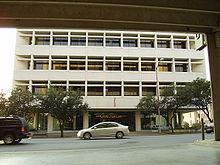
Highly rated elementary and secondary schools contribute to both quality of life and the beginnings of exceptional labor pools to come. Austin area households enjoy diverse options in education, including 29 public school districts, 17 charter schools and 69 private schools.[174] Most of the city is served by the Austin Independent School District. This district includes notable schools such as the magnet Liberal Arts and Science Academy, which, by test scores, has always been within the top thirty high schools in the nation, as well as The Ann Richards School for Young Women Leaders. Some parts of Austin are served by other districts, including Round Rock, Pflugerville, Leander, Manor, Del Valle, Lake Travis, Hays, and Eanes ISDs. Four of the metro's major public school systems, representing 54% of area enrollment, are included in Expansion Management magazine's latest annual education quality ratings of nearly 2,800 school districts nationwide. Two districts aeEanes and Round Rock aeare rated "gold medal", the highest of the magazine's cost-performance categories.[174]
Private and alternative education institutions for children in preschool-12th grade include Regents School of Austin, Redeemer Lutheran School, Garza (public), Austin Discovery School (public charter), Austin Jewish Academy, The Austin Waldorf School, The Griffin School, The Khabele School, Concordia Academy, St. Ignatius Martyr Catholic School,Holy Family Catholic School, San Juan Diego Catholic High School, Brentwood Christian School, St. Austin Catholic School, St. Stephen's Episcopal School, St. Mary's, St. Theresa's, St. Michael's Catholic Academy, St. Gabriel's Catholic School, St. Andrew's Episcopal School, St. Francis Episcopal School, Saint Paul Lutheran School, Trinity Episcopal School, Huntington-Surrey, Cleaview Sudbury School, The Inside Outside School, ACE Academy, Paragon Preparatory Middle School, Austin International School, The Progress School and a number of Montessori schools.
Along with vibrant homeschooling & "unschooling" communities, Austin is home to a number of part-time learning environments designed to offer basic academics and inspired mentoring. Such current resources include the Whole Life Learning Center & AHB Community School.
Austin is also home to numerous child developmental institutions including the Center for Autism and Related Disorders, the Central Texas Autism Center, Autism Early Learning Center, Johnson Center for Child Health and Development and many more.
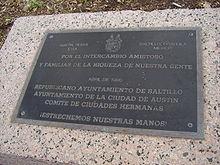
List of sister cities of Austin, Texas, designated by Sister Cities International.[175]
The cities of Belo Horizonte, Brazil and Elche, Spain were formerly sister cities, but upon a vote of the Austin City Council in 1991, their status was de-activated.[176]


Word Count: 10099






